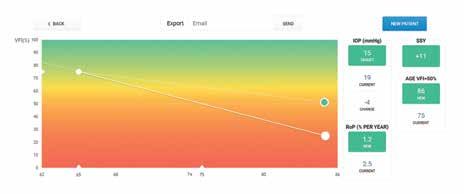
4 minute read
Web-based tool helps
Preventing severe vision loss
Novel web-based tool helps with decisions on lowering the target IOP. Cheryl Guttman Krader reports
The Save Sight Years (SSY) Engine should aid clinicians in their management of patients with glaucoma who are showing an unacceptable rate of perimetric progression. Intended to offer a guide for choosing a new target IOP that will reduce the risk of severe vision loss, the SSY Engine gives an individualised estimation of future disease progression rates in relation to different levels of IOP.
It was created by Anders Heijl MD, PhD, Skåne University Hospital, Malmö, Sweden, and Magnus Brandel, Allergan, with financial support from Allergan. An article in Acta Ophthalmologica co-authored by Dr Heijl and Mr Brandel describes the rationale for the development of the SSY Engine and how it is used.
“Although clinicians have been able to extrapolate Rate of Progression (RoP) regression lines to identify eyes that are progressing at an unsafe rate and need further reduction of IOP, the SSY Engine adds something novel for assisting with the difficult and not always intuitive task of resetting the target IOP. By using the information, it provides in conjunction with other clinical aspects and their expert judgment, clinicians may be better equipped to make decisions on how best to intensify treatment,” Dr Heijl explained.
Dr Heijl told EuroTimes that discussions leading to the development of the SSY Engine began in 2014, and the first version was launched in 2016. The system itself is an outgrowth of the SSY Concept that was introduced by Allergan in the form of an education programme several years earlier.
The SSY Engine is CE-marked and has been available as an app for a few years in a number of countries. Now it is being launched as a web-based version (www. ssyengine.com) in which the analyses can
SSY Engine analysis of a glaucomatous eye of a 65-year-old patient who has been followed for three years with a mean IOP of 19mmHg. The measured rate of progression of 2.5%/year is not safe (the extrapolated solid line). The engine suggests that if a new target IOP of 15mmHg is achieved, the rate of progression might be reduced to approximately 1.2%/year; a much improved outcome (dotted line)
be performed in the cloud.
“It became clear to us that the iPad and Android tablets were not the optimal platform for our system because these devices are not used that much in ophthalmic outpatient practices,” said Dr Heijl. “With the web-based analyses, there is no need for users to download any software. Furthermore, because the analyses are completely anonymous, there are no concerns about patient confidentiality.”
To use the SSY Engine, clinicians input four items found on the perimetric results form – the patient’s age at the first visual field, current age, the current Visual Field Index (VFI, if using a Humphrey perimeter) or the current Mean Defect (MD, if using the Octopus perimeter) and the measured RoP. As a fifth item, they enter the patient’s mean IOP, which is estimated from the patient records and includes values measured after the patient was started on IOP-lowering treatment and during the period for which the RoP was calculated.
The SSY Engine then generates a graph of the current RoP trendline extrapolated 20 years into the future. Using a mouse,
clinicians can then reduce the slope of the trendline to areas in the age/function diagram with better visual field status, where patients’ vision-related quality of life would be less affected. For each age-based simulation, the SSY Engine will display the new target IOP, the recalculated RoP (% per year) and the number of “Sight Saved Years”.
Dr Heijl said that it is probably best to wait to use the SSY Engine until data are available from five or six visual fields, which would occur about two-to-three years after a patient is diagnosed with glaucoma and the RoP becomes available for the first time.
“However, the SSY Engine can be potentially valuable for assisting with management decisions at any time when the rate of disease progression seems unacceptable or threatening,” he said.
The web-based SSY Engine is currently available in about a dozen European countries along with Australia, Brazil, and India, and it will be launched in more countries in 2021. Dr Heijl acknowledges that the SSY Engine calculates IOP based on the “best current knowledge”, which comes from four multi-centre randomised glaucoma/ocular hypertension treatment trials. Studies validating the performance of the SSY Engine would be valuable, he said.
“We are looking seriously at conducting a validation study and believe that it would be feasible using patients who were implanted with the XEN Gel Stent. We also invite other researchers to apply the SSY Engine on their data,” Dr Heijl said.
Courtesy of Anders Heijl MD, PhD








